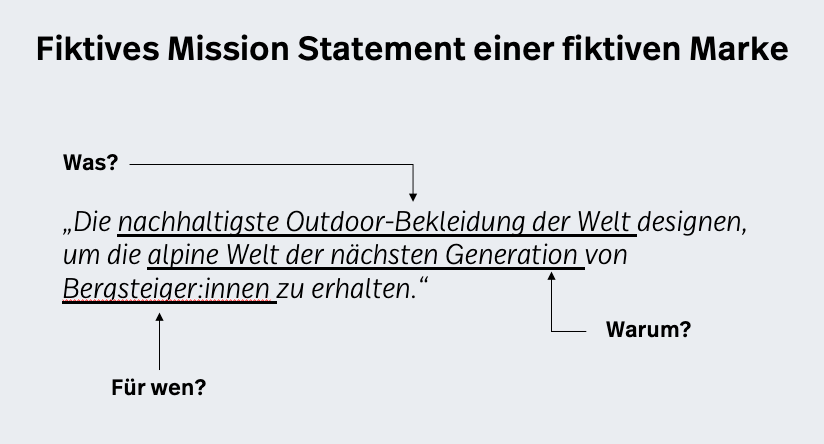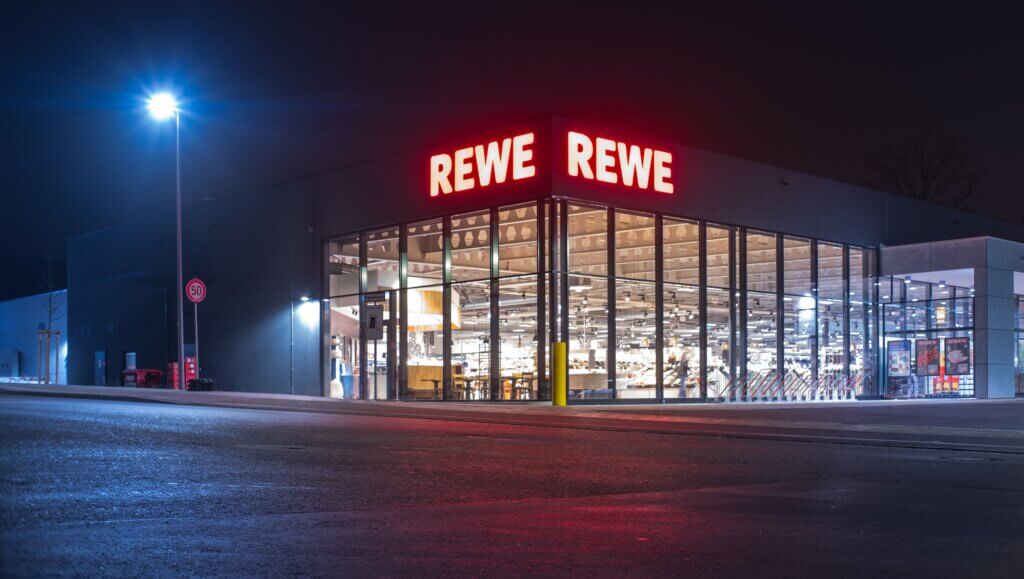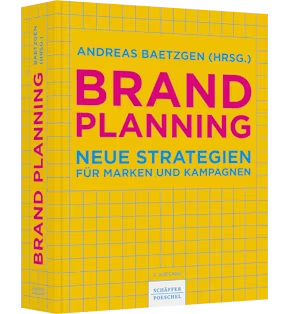Vision and mission are classics of strategic brand management. By formulating them, companies give themselves a direction in the market that should have a lasting effect and lead to the goal in concrete steps. But beware: both statements need to be consciously formulated in order to have a lasting effect in terms of a brand.
Vision & mission: two sentences that define brands
In a world that seems to turn faster every day for brands, consistency is more important than ever. Vision and mission are concisely formulated guiding principles that are intended to do just that. They should express, how a company wants to change the world and by what means it wants to do so. Mission and vision are meta-strategy formulations. They are used to derive guiding principles and value frameworks.
They work outwards, inwards and forwards. This means that if they are well formulated and accurately describe the brand, they can have an impact on current and future employees (employer branding), customers and future innovations. Mission and vision describe where an organisation wants to go and how it wants to do so. As guiding principles, they provide a framework for all marketing disciplines.
What is a vision statement?
The vision statement describes how a company wants to change the world for the better in the long term. The vision should have an inspiring effect and be able to inspire with a certain grandeur. The focus here should not be on the mundane things of business (sales development, EBID, industry position) but on the deeper, holistic reason why a company exists on the market at all.
Leitfrage: Was verändert unsere Existenz langfristig positiv in der Welt?
What is a mission statement?
A mission statement describes how a company intends to practically shape the path to this grand vision. The mission statement should also play on a certain meta-level and contain a range of inspiring - yet precisely outlined - possibilities. But it is more practical, more concrete and asks what an organisation needs to do today in order to change the world tomorrow.
Key question: What can an organisation do for whom and why?

Wie unterscheiden sich Vision und Mission?
Vision und Mission greifen zusammen mit der Markenpositionierung und dem Marken-Branding ineinander. Sie bauen aufeinander auf und sollten so geschrieben sein, dass sie als Marketing-Begriffspaar gut zusammen funktionieren. Als Marketing Consultancy we have supported various clients in finding their vision and mission. We are convinced that vision and mission can still be important modules in the branding and brand management of companies IF they are consciously written.
- Vision: Is the desired change of state that the existence of our brand brings to the world. What changes with us in the long term that would not change without us? Where does our brand make a difference?
- Mission: Is the way to get there. The concrete steps it takes to bring a big long-term idea into the world. The things that guide us every day on the path to big change. The many small things that drive us forward.
At superspring we are always honest. So now let us be too: A great many corporate strategies in this world are Pseudo-strategies. They are written to be written. They are supposed to give the feeling that you have ticked all the boxes when it comes to brand management and strategy. But they don't actually differentiate, they don't provide any concrete guidance for brand and communication work and they don't achieve anything else either.
This is especially true for vision and mission. Many companies have adopted guiding principles that, at best, don't break anything. In fact, many could have saved themselves the exercise and simply managed without a vision or mission statement. After all, vision and mission are elements of active brand management. They need to be statements and they need to define a clear place for the organisation in the world.
‘If you have visions, see a doctor.’
- Helmut Schmidt, former German Chancellor
Formulating vision and mission correctly
There are various ways to formulate a good vision/mission statement. For example, by contacting us and we develop your brand mission statement holistically and with workshop support. If you want to develop both yourself, simply follow the steps below.
Vision statement: tips and formulation aids
A company's vision should be able to endure for a long time. It must therefore be literally visionary in the way it organises the company. It should clearly explain how the company behind it wants to change the future for the better. And in a way that can only be tackled here and now by and with this company.
A well-formulated vision statement is convincing:
- AttitudeA good vision statement reflects the strategic direction of the company and ensures that everything can be done to actually change the future positively in line with the vision.
- Future focusA vision aims to achieve long-term goals that go beyond short-term gains. It defines where the company wants to get to in the next 5, 10 or 20 years.
- InspirationA strong vision inspires and motivates. It creates an emotional connection and inspires both employees and customers in the long term and with that goosebump feeling.
- ClarityThe vision must be formulated clearly and comprehensibly in a few words. It should be easy to remember and communicate. A good vision statement is memorable and easy to reproduce.
- DifferentiabilityA strong vision sets the company apart from the competition and creates a unique target perspective and a will to change that no other market participants share.
Mission statement: tips and formulation aids
Similar to the vision statement, the mission statement also has a clear task. Both formulations build on each other. The mission statement should help to practically underpin the long-term vision (a desired change of state) that has just been formulated. A well-formulated company mission should help answer three questions:
- What? What exactly do we do? What type of product or service do we offer or want to sell on our markets?
- Why? With what goal are we doing this? What kind of world do we want to create or change with our products?
- For whom? Who are we targeting? Why do we make these people's lives better and how can we clearly demarcate them?
A strong mission is crucial for the everyday life of a brand, as it must be realisable. A mission statement worthy of the name becomes the guideline for many brand and marketing decisions. If implemented correctly, the corporate vision and mission should be recognisable in every marketing measure, regardless of whether it is the Branding or the Content Strategy of the company.

Examples: Vision and mission of well-known brands
Some of the world's best-known brands work with explicitly formulated vision and mission statements. They all demonstrate well that a well-written vision and mission framework is a guiding star for brands, Communication strategy and even for the Content strategy can serve. However, some of the examples also show that mission vision statements often become a compromise (which should be avoided).
Important: The following examples are for illustrative purposes only. They have not been developed by superspring.
superspring Notes:
Our newsletter about new brand management.
The superspring newsletter with our look at what's coming in marketing - and, of course, what we contribute to it. Sent out regularly and can of course be cancelled at any time.
Daimler: Vision & Mission Statement
In its vision-mission statement, the Daimler car brand has to manage the balancing act between desirability and a secure future in the context of climate change. No easy task and an example of how mission and vision are also subject to change. The statements formulated by the Daimler brand can be found on its Strategy pages here and here.
Vision:
We build the most desirable cars in the world.
Mission:
As pioneers of the automobile, we want to shape the mobility of the future safely and sustainably.

In addition to premium vehicles, clearly formulated mission and vision statements also play an important role in retail, as the brand must be consistently recognisable - usually on a large scale - and reproducible for employees:
Rewe: Vision & Mission Statement
As the purchasing cooperative that it actually is, the Rewe Group has to kill many birds with one stone. In this respect, Rewe's mission and vision statement reads somewhat generic in our view. Admittedly, the derivation of the brand for its Guiding principle becomes clearer when you look at the resulting values.
Vision:
The best performance - for customers, merchants and employees.
Mission:
Together for a better life.

You can always learn what works from the greats of brand management. Even if you have to admit that Americans have always found it a little easier to produce crisp statements.
Nike: Vision & Leitbild
For decades, NIKE has wanted to provide athletes around the world with what it takes to be an athlete. It's always about reaching the next level for athletes - whatever that may be. More info on Nike's mission statement can be found here.
Vision:
To remain the most authentic, connected, and distinctive brand.
Mission:
To bring inspiration and innovation to every athlete* in the world.
*If you have a body, you are an athlete

Radically user-centred - this is how another global brand star presents itself with its mission-vision statement. amazon's vision clearly sets the framework for its global expansion:
amazon: Vision & Mission Statement
From amazon Prime to AWS: hardly any other company in the world has made radical customer-centricity such a corporate guideline as amazon. This is easy to understand when you look at the company's vision and mission.
Vision:
„To build a place where people can come to find and discover anything they might want to buy online.”
Mission:
To be Earth’s most customer-centric company.

Und auch im B2B-Bereich spielt eine klare Ausrichtung für jede Marke eine entscheidende Rolle. Das macht ein weiterer Star der Software-Szene aus Baden Württemberg klar.
SAP: Vision & Leitbild
The software megacorporation SAP feeds its mission vision primarily from the statement ‘Run better’, which is most likely based on its role in the logistics business. The statements can be found here.
Vision:
Our vision is to help the world run better and improve people s lives.
Mission:
SAP helps companies of all sizes and industries run better.

How superspring integrates mission and vision
As a Marketing Consultancy we at superspring regularly position companies in their markets and build brands. Vision and mission are important elements in brand building. However, they exist alongside and interact with other brand elements such as corporate values, purpose statements, brand manifestos and other brand guideline modules. In our experience, many companies now tend to over-engineer their brands. Many well-defined brand elements stand side by side, but in everyday life they hardly have the impact they were once intended to have.
This raises the question of how purpose and vision interact. One is intended to show the sustainable perspective of an organisation. The other should mark the long-term positive change in the world that an organisation wants to bring about. But shouldn't both statements be congruent? Can a company today still afford a vision statement that cannot somehow also have a sustainable impact? We think not.
The trend is therefore moving back towards simpler brand models. Patagonia, for example, is adopting a standardised mission statement without formulating a corporate vision. The text of the mission statement reads: ’build the best product, cause no unnecessary harm, use business to inspire and implement solutions to the environmental crisis.’ Other brands are also following this example, because the coexistence of many strategy statements, some of which cannibalise each other, contributes to confusion rather than greater clarity.
Brands for a networked world
Conclusion: Vision and mission need to be applied
Vision and mission provide companies with a conceptual and substantive framework if their importance is taken seriously. They illustrate the reason why a company was founded in the first place (vision) and represent the steps to get to this point (mission). As a framework, they should inspire, emotionalise and create loyalty - but above all they should remind people in the long term why an organisation exists.
No matter how you approach the formulation of your own vision and mission, one thing is clear: as guidelines for brands, vision and mission statements can only be effective if they are accepted and integrated into everyday life. They are the beginning of a long journey for brands. Active entrepreneurs, brand and marketing managers can use them to create strong brands that can make a real difference in the market with active value frameworks.
Only those brands can be successful that also practically translate their brand guidelines into consistent brand experiences and Communication plans, in Storytelling and in Digital marketing strategies translate. Vision and mission are more than just two sentences that appear on company websites and at the front desk. They are strategic frameworks for practical brand work. They demand attention and they permanently demand the role they are intended to play as strategic assets.
Read more:
„Leading brands in real time: How interaction data makes brand management richer‘ is the title of the superspring contribution to Prof Andreas Baetzgen's marketing bestseller ’Brand Planning. New strategies for brands and campaigns„. Many great colleagues worked alongside us on this book, which we would like to recommend without reservation. More here >
Picture credits
- Mercedes: Photo from Alexis AMZ DA CRUZ on Unsplash
- Rewe: Photo of Josh Redd on Unsplash
- Nike: Photo from Paul Steuber on Unsplash
- SAP: Photo from Adrian Sulyok on Unsplash



